Major Theories of Intelligence: A Review
How is the Trident G Theory Positioned in the Space of Established Theories?
Intelligence has long been a subject of debate, with competing theories offering differing perspectives on its structure and origins based on the empirical findings. Traditional factor-analytic models - such as Spearman’s two-factor theory and later developments like the Cattell–Horn–Carroll (CHC) model - conceptualise intelligence as a hierarchical system culminating in a general factor, g, though contemporary interpretations often emphasise multiple broad abilities (e.g. fluid and crystallised intelligence) rather than a single, unitary g. In contrast, Mutualism Theory posits that cognitive abilities develop in a reciprocal, self-reinforcing manner, giving rise to an emergent g without a central causal factor. Network theories further reframe intelligence as the emergent product of dynamic interactions among a web of interconnected cognitive processes, while Process Overlap Theory (POT) explains the positive correlations among diverse tasks as the result of overlapping domain-general processes. This essay critically examines these established perspectives and situates my Trident G Theory in this space - a novel, integrative model that synthesises elements from each framework by incorporating a dynamic, recursive ‘g-loop’ grounded in predictive processing and brain criticality, thereby accounting for both stable, automated and flexible, adaptive aspects of intelligence.
1. Factor-Analytic Theories
Hierarchical Structure (with g at the apex in traditional models)
Traditional factor-analytic models, such as Spearman’s two-factor theory, posit that a single general intelligence factor, g, underlies all cognitive abilities. In these models, g sits at the apex of a hierarchy. Below g are intermediate broad abilities - such as fluid reasoning (Gf), crystallised knowledge (Gc), short-term memory, long-term memory retrieval, and processing speed - that in turn are supported by more specific, narrow abilities (e.g. particular memory or perceptual skills). In this view, performance on specific tasks contributes to narrow skills, these cluster into broad abilities, and together they form the overall general factor g.
Contributions of Lower-Order to Higher-Order Factors
In hierarchical models, lower-order abilities are seen to contribute to higher-order ones. For instance, various memory tasks might load onto a Memory factor, while different speed-related tasks contribute to a Processing Speed factor. In traditional models, these broad abilities are all assumed to feed into a single overarching g. However, contemporary models such as the Cattell–Horn–Carroll (CHC) theory offer a more complex picture. In CHC, while a general factor is often statistically recoverable, the emphasis is on the distinction between multiple broad abilities - most notably, fluid intelligence (Gf) and crystallised intelligence (Gc). Here, the broad abilities are treated as distinct, with their own sets of narrow skills, rather than being seen as mere subsets of a singular g. In fact, some recent interpretations of CHC and related models suggest that the positive correlations across diverse cognitive tests (the positive manifold) might reflect overlapping domain-general processes rather than a single, unified intelligence factor.
Stable Trait Structure (Psychometric Validation)
Historically, hierarchical theories have treated intelligence as a stable, trait-like structure of abilities. Decades of IQ test data have revealed a consistent pattern: diverse tests tend to cluster into broad factors, and these factors often correlate positively, leading to the statistical recovery of a g factor. For example, Carroll’s analysis of over 400 datasets confirmed a three-stratum hierarchy with one general factor accounting for a significant portion of the variance in cognitive tests. Because IQ tests are widely used, interpretiung this common g factor as some determinate property of human brains is often assumed for practical purposes. Nonetheless, modern research indicates that this singular g might be an emergent property of several interacting processes rather than a single underlying entity.
Summary
Classic hierarchical models traditionally depict intelligence as an organised pyramid with general intelligence (g) at the summit, supported by broad and narrow abilities. However, more recent iterations - particularly the CHC model - emphasise the distinction between different broad abilities (like Gf and Gc) and suggest that the positive manifold observed in IQ tests may arise from shared domain-general processes. Despite these nuances, the practical interpretation of IQ tests often assumes a common g factor - one reason arguably why this has become fixed in popular imagination about the nature of intelligence.
2. Mutualism Theory
Bidirectional Ability Interactions and Reciprocal Growth
Mutualism Theory proposes that cognitive abilities develop together by influencing each other in a reciprocal, bidirectional way. Rather than a rigid top‐down hierarchy, this view is inherently dynamic – as a child develops, improvements in one cognitive domain (for example, working memory or vocabulary) can directly enhance other domains (such as reasoning or learning capacity), and vice versa. Each ability serves as both cause and effect in relation to others. For instance, better memory can lead to the acquisition of more knowledge, which in turn improves reasoning strategies; concurrently, the active practice of reasoning can enhance memory or attentional processes. This mutual reinforcement enables cognitive skills to bootstrap one another’s growth, leading to correlated improvements over time - a positive feedback loop (soemtimes called a ‘multiplier’) that underpins overall ability development.
No Causal g Factor – Intelligence as an Emergent Property
In mutualism, there is no single, inborn general factor (g) driving all cognitive abilities. Early in development, different cognitive skills may start out relatively independent; as they interact and mutually reinforce one another, an apparent general factor “g” emerges as a byproduct of these positive interactions. In other words, g is not a fixed, pre-existing trait but an emergent outcome of multiple abilities growing together. This contrasts with traditional hierarchical models, as mutualist theorists explicitly reject the notion of a central causal g. Instead, the well-known positive manifold - the observation that scores across diverse cognitive tests tend to correlate - is explained by the fact that each ability benefits other abilities over time. The model by van der Maas et al. (2006) demonstrated that if you simulate many cognitive skills that enhance each other’s development, a pattern of positive correlations and an apparent general factor naturally arise without requiring a single core ability to cause them. Thus, in this framework, intelligence is best understood as an emergent network of interdependent competencies.
Developmental Reinforcement and Self-Organising Growth
Mutualist theories place a strong emphasis on developmental dynamics. They account for phenomena such as the age-related strengthening of the g factor - where, as children grow, their cognitive networks become increasingly integrated through reciprocal influences, making measures of g more pronounced in later childhood and adolescence. These theories also help explain why predicting adult IQ from infant behaviour is challenging; early in development, the “network” of abilities is not yet tightly interconnected. Over time, even small initial advantages in certain cognitive processes can compound - for example, a child with slightly better attention might learn more effectively, which in turn boosts other skills and leads to an overall advantage. In essence, intelligence is viewed as a self-reinforcing system, where the cognitive architecture organises itself through use and learning. This self-organising, developmental aspect is central to mutualism: abilities continuously interact and co-develop, so the structure of intelligence is built from ongoing interactions rather than being assumed fixed from the start. Consequently, mutualist theories portray intelligence as dynamic and context-dependent, with practice, education, and inter-skill interactions fundamentally shaping one’s overall cognitive ability.
3. Network Theories
Intelligence as a Network of Interconnected Abilities
Network theories conceptualise intelligence not as a single trait or a strictly hierarchical pyramid but as a web of interconnected cognitive abilities. In this approach, each cognitive skill (e.g. verbal ability, spatial ability, memory, etc.) is treated as a node within a network, and the connections (edges) between nodes represent direct relationships or influences among these skills. Global intelligence is viewed as an emergent property of the entire network - arising from the pattern and strength of these connections - rather than being localised in any single node. This means that no one ability holds special status as the general factor; instead, g emerges from the interplay among many components. Visualising intelligence as a graph, overall cognitive ability corresponds to the degree of connectivity and integration across the network. The more collectively connected the network, the higher the effective intelligence, providing an alternative explanation for the positive manifold observed in IQ tests.

Graph-Theoretic Properties (Centrality, Clustering, etc.)
Since network theories represent cognitive structure as a network, they naturally draw on graph theory concepts. Researchers examine metrics such as centrality (which nodes are most connected or influential in the network) and clustering (how nodes group into interrelated subgroups) to understand cognitive organisation. For example, a network of cognitive tests might reveal a “math cluster” formed by arithmetic, algebra, and geometry items, and a “verbal cluster” from vocabulary and reading items, with interconnections linking these clusters. Nodes with high strength centrality - those that are strongly connected with many other abilities - can be seen as analogous to the general factor g. Rather than positing g as a latent variable at the apex, network theorists interpret these highly central nodes or tightly integrated hubs as responsible for the observed positive correlations among tests. In addition, the community structure (or clustering) within the network can mirror group factors like Gf and Gc without requiring a strict hierarchical arrangement. Overall, graph-theoretic metrics provide a sophisticated picture of cognitive organisation, offering insights into why certain skills are more influential than others.
Rejection of a Single g and Emphasis on Flexibility/Adaptability
Network theories inherently reject the idea of a singular, fixed g factor that is identified with a determinate, genetically based property of the brain - instead viewing intelligence as a dynamic, context-dependent property. Since the network’s configuration determines cognitive performance, these theories emphasise the importance of flexibility - how efficiently the network can reconfigure and communicate. In line with findings from network neuroscience, individuals with higher intelligence often show more efficient global brain network organisation and greater network flexibility (i.e. the ability to rapidly shift connectivity patterns when faced with new challenges). This suggests that intelligence may be best understood as the adaptive self-organisation of one’s mental network in response to evolving demands. For example, when confronting a novel task, a high-IQ person’s brain might quickly recruit and integrate multiple networks, whereas a lower-IQ brain may display more rigid or segregated connections. Thus, network theories portray intelligence as an emergent, flexible, and multi-dimensional property of a well-connected and adaptable system of cognitive abilities, rather than a fixed trait emanating from a single source. This perspective underscores that modifying or improving connections through learning can dynamically alter overall cognitive performance.
4. Process Overlap Theory (POT)
Intelligence from Shared Domain-General Processes
Process Overlap Theory argues that what we call ‘intelligence (and the g factor construct) arises from a set of domain-general cognitive processes that most tasks draw upon. Many cognitive tests engage general executive functions - such as attention control, working memory capacity, processing speed, and executive reasoning -alongside task-specific skills. Because these core processes are required across a wide variety of tasks (for example, solving a math problem or a verbal puzzle both typically involve working memory and attentional focus), they create an overlapping demand. POT suggests that every cognitive task is composed of both general-process demands and task-specific demands, and it is this overlap that produces the positive correlations observed between different tests.
Overlap of Processes Versus a Single g Factor
Rather than postulating a single, mysterious ‘general ability,’ POT proposes that g is simply the statistical outcome of multiple cognitive processes operating in concert. There isn’t one singular mechanism underlying all intelligent behaviour; rather, many processes overlap across tasks, collectively giving the appearance of a single factor. In other words, g is a byproduct of task overlap in the brain: tasks correlate with each other because they each tap into several of the same mental resources. Research supporting POT has demonstrated that even very elementary cognitive tasks (designed to be simple) involve several processes, so that individual differences reflect multiple components. Consequently, general intelligence can be explained without assuming one ‘entity’ – it emerges from the combined influence of a bundle of cognitive processes. This view aligns with the idea that individuals possess various broad cognitive resources (such as attentional capacity and processing efficiency), and the more of these resources one can effectively deploy, the better one tends to perform across the board.
Task-Specific Demands and Dynamic Process Interaction
POT further emphasises how different tasks recruit overlapping sets of processes to varying degrees. A complex reasoning test might heavily involve working memory, attentional control, and processing speed, whereas a simpler task might require fewer of these general processes and rely more on specific skills. The pattern and degree to which these processes are engaged explain the structure of intelligence test correlations. Importantly, this view implies a dynamic interplay of processes: when attempting a task, multiple cognitive processes interact in real time to determine performance. For instance, if both working memory and attention are already at capacity, additional domain-specific skill may not further improve performance. Thus, intelligence is not a static, singular capacity but the aggregate efficiency of many processes working together. POT is a hybrid approach in that it acknowledges the existence of distinct cognitive processes (as in a multiple-abilities perspective) while explaining the emergence of a unitary g as a result of their overlap and concurrent operation. This theory is bolstered by evidence from cognitive psychology and neuroscience showing that many tasks share common brain circuits and mental resources.
Summary
Process Overlap Theory depicts general intelligence as the result of overlapping cognitive mechanisms - chiefly domain-general executive processes - that are engaged across diverse tasks. It shifts the explanation of the positive manifold from the notion of a single “power” of the mind to the idea of a shared pool of processes. Consequently, individuals who possess stronger or more efficient general processes tend to excel in many areas, providing an account of why cognitive performance is so broadly correlated.
Trident G Theory and Classic Intelligence Theories
Factor-Analytic Theories
Similarities: Trident G acknowledges a hierarchical structure of cognitive abilities similar to CHC and other g-based models. It posits broad abilities (e.g. fluid intelligence Gf and crystallised intelligence Gc) that combine into an overall general adaptive ability (G) that reflects a near critical state of a complex system. Trident G, like traditional factor models, believe that G has causal powers, and is structured hierarchically, and that this accounts for the positive manifold of correlations among diverse tasks through a structured, coordinated set of broad abilities (captured by Gf - Gc dynamics).
Differences: Unlike static hierarchical models that treat g as a fixed latent factor, Trident G emphasises dynamic, recursive processing. Intelligence in Trident G emerges from a ‘g-loop’ of ongoing cognitive operations – the brain’s generative model constantly making predictions and updating them with feedback (minimising prediction errors) Traditional g models rely on factor loadings from tests to factors, whereas Trident G describes intelligence as a self-organising process that continually refines itself. This recursive mechanism (inspired by the Free Energy Principle and brain criticality) marks a departure from the one-way, top-down influence of g in hierarchical factor-analytic theories. In short, Trident G retains a layered structure of abilities but adds a feedback-driven dynamism absent in classic CHC-style models.
Mutualism Theory
Similarities: Both Trident G and mutualist theories view general intelligence as an emergent property of interacting cognitive skills that can evolve - increase over time - rather than as a pre-existing single fixed magnitude. In mutualism, cognitive abilities mutually reinforce each other over development – improvements in one domain boost others, producing the positive manifold without any central g. Trident G aligns with this view: it treats core capacities like working memory, reasoning, etc., as a network of ‘nodes’ that bolster one another, driving overall cognitive growth. In both frameworks, intelligence develops bidirectionally – skills co-evolve through positive feedback, explaining why diverse talents tend to advance in tandem.
Differences: Trident G extends beyond mutualism by focusing on a core subset of functional abilities that interact in the developmental process.
Network Theories
Similarities: Trident G’s emphasis on interconnected cognitive processes and their dynamic interplay resulting in emergent properties closely mirrors network-based theories of intelligence. Modern network neuroscience views intelligence as arising from system-wide connectivity and interactions among brain regions or cognitive nodes, rather than any single area or factor. Similarly, Trident G portrays the mind as a near-critical network balancing integration and flexibility – fluid reasoning, crystallised knowledge, inference ability and resilience interlink to produce adaptive intelligence
Both perspectives stress that global structure (the configuration of connections among many elements) is key: Trident G, like other network models, suggests general intelligence emerges from the holistic organisation of cognitive components engaging together, not from isolated capacities.
Differences: Unlike purely emergent network models, Trident G maintains a degree of structured processing within its network. Many network theories treat intelligence as an outcome of diffuse interactions without a central coordinating process, whereas Trident G proposes a specific architectural loop (the generative G-loop) that orchestrates these interactions. In practice, Trident G identifies distinct functional modes and components – e.g. Control Mode vs. Creative Mode, and The Gf-Gc axis – which imposes an analytical structure on the cognitive network. Network models in the strict sense often forgo such predefined structure, letting all connections emerge organically.
Process Overlap Theory (POT)
Similarities: Trident G and Process Overlap Theory both reject the notion of a singular, causal g and instead explain general intelligence via a number of overlapping broad abilities POT argues that cognitive tests correlate positively because they all tap into overlapping executive functions (such as working memory and attention control) in addition to their domain-specific content.
This aligns with Trident G’s view that broad cognitive processes described by the g loop are engaged across all cognitive tasks, yielding an apparent g-factor as a byproduct of their common involvement. In essence, both theories locate the source of g in the shared processes required by diverse mental activities – not in a single general ability, but in the intersection of many neural/cognitive functions acting together.
Differences: Trident G moves beyond POT’s largely statistical description of overlap by offering a mechanistic model of how those domain-general processes operate. Process Overlap Theory explains what causes the positive manifold (overlapping executive demands) but does not specify how these processes interact in real time. Trident G provides that how via its structured g-loop: it describes an ongoing cycle of prediction, learning, and adaptation that physically implements the engagement of domain-general skills across tasks In other words, POT treats the common processes as an abstract overlap, whereas Trident G embeds them in a formal architecture (informed by free-energy minimisation and critical brain dynamics) that actively governs problem-solving and learning. Additionally, Trident G incorporates an emergent network-based brain criticality (phi) and allostatic resilience into its account of general intelligence, extending beyond the cognitive-focus of POT.
And while Process Overlap Theory emphasizes a set of universal cognitive processes - like working memory, updating, and inhibition - as the shared basis for intelligence, Trident G shifts the focus. It posits that general intelligence arises from how the brain continuously builds, refines, and updates generative models through inference. In this view, the overlap comes not from isolated cognitive functions, but from the integrated process of predictive modeling and error-driven learning (the interplay of δ, α, ϕ(s), and θ(x)). This framework inherently includes functions like working memory and updating, but it frames them as components of a broader system for modeling and inference across domains.
References
Classic Factor-Analytic Theories (e.g. g and Gf/Gc theories)
Carroll, J. B. (1993). Human cognitive abilities: A survey of factor-analytic studies. Cambridge University Press.
Cattell, R. B. (1963). Theory of fluid and crystallized intelligence: A critical experiment. Journal of Educational Psychology, 54(1), 1–22. https://doi.org/10.1037/h0046743
Horn, J. L. (1965). A rationale and test for the number of factors in factor analysis. Psychometrika, 30(2), 179–185. https://doi.org/10.1007/BF02289447
McGrew, K. S. (2009). CHC theory and the human cognitive abilities project: Standing on the shoulders of the giants of psychometric intelligence research. Intelligence, 37(1), 1–10. https://doi.org/10.1016/j.intell.2008.08.004
Mutualism Theory
van der Maas, H. L. J., Dolan, C. V., Grasman, R. P. P. P., Wicherts, J. M., Huizenga, H. M., & Raijmakers, M. E. J. (2006). A dynamical model of general intelligence: The positive manifold of intelligence by mutualism. Psychological Review, 113(4), 842–861. https://doi.org/10.1037/0033-295X.113.4.842
Network Theories
Barbey, A. K. (2018). Network neuroscience theory of human intelligence. Trends in Cognitive Sciences, 22(1), 8–18. https://doi.org/10.1016/j.tics.2017.10.001
Den Hartigh, R. J., Van Dijk, M. W., Steenbeek, H. W., & Van Geert, P. L. (2016). A Dynamic Network Model to Explain the Development of Excellent Human Performance. Frontiers in psychology, 7, 532. https://doi.org/10.3389/fpsyg.2016.00532
McGrew, K. S., Schneider, W. J., Decker, S. L., & Bulut, O. (2023). A psychometric network analysis of CHC intelligence measures: Implications for research, theory, and interpretation of broad CHC scores “beyond g.” Journal of Intelligence, 11(1), 19. https://doi.org/10.3390/j.intelligence11010019
van der Maas, H. L. J., Kan, K.-J., & Borsboom, D. (2017). Intelligence is what the intelligence test measures. Seriously. Journal of Intelligence, 5(2), 15. https://doi.org/10.3390/jintelligence5020015
Process Overlap Theory (POT)
Kovacs, K., & Conway, A. R. A. (2016). Process overlap theory: A unified account of the general factor of intelligence. Psychological Inquiry, 27(3), 151–177. https://doi.org/10.1080/1047840X.2016.1153946
Kovacs, K., & Conway, A. R. A. (2019). A unified cognitive/differential approach to human intelligence: Implications for IQ testing. Journal of Applied Research in Memory and Cognition, 8(3), 255–272. https://doi.org/10.1016/j.jarmac.2019.05.003






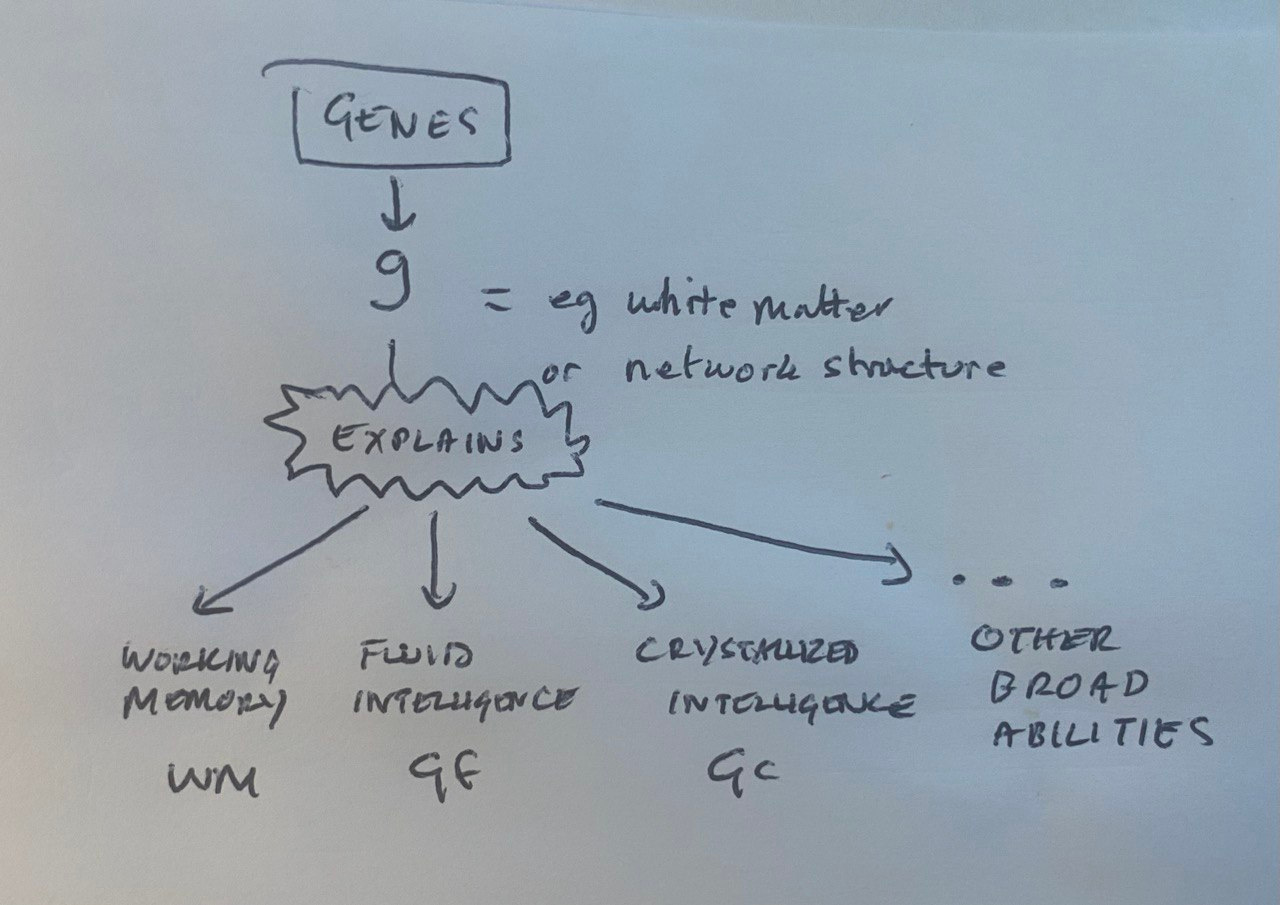
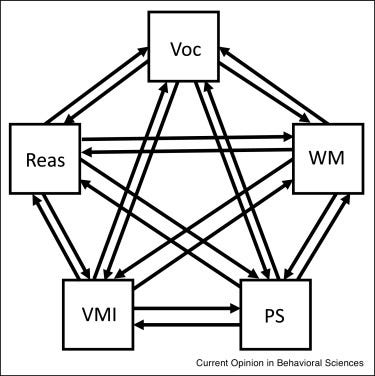
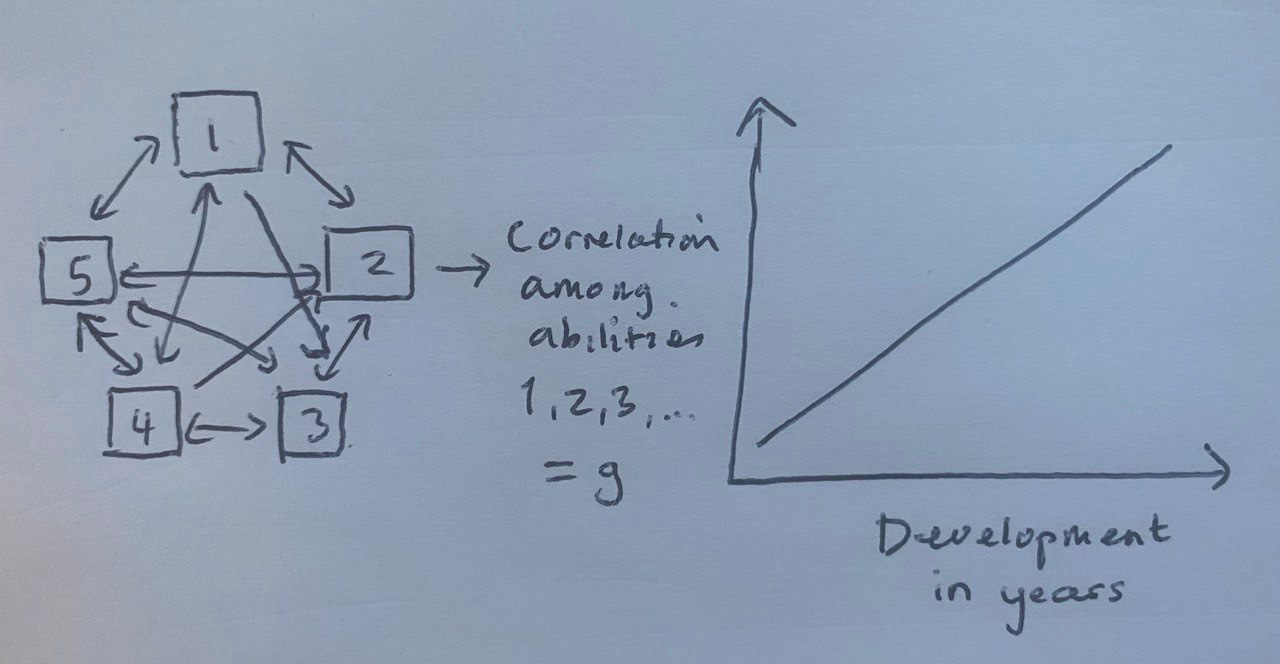
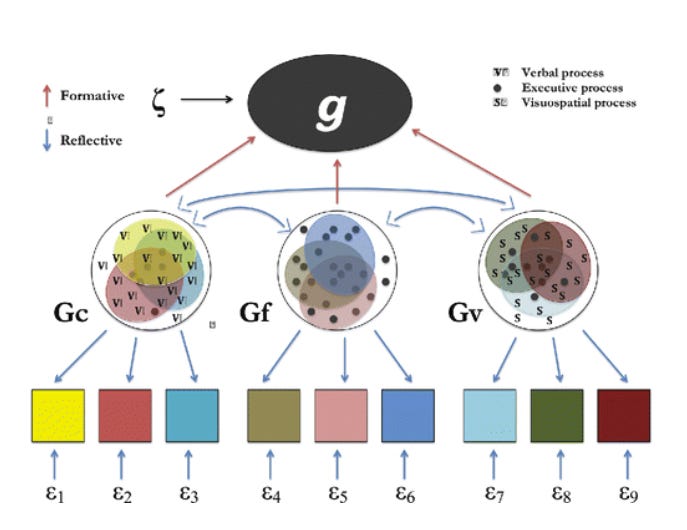
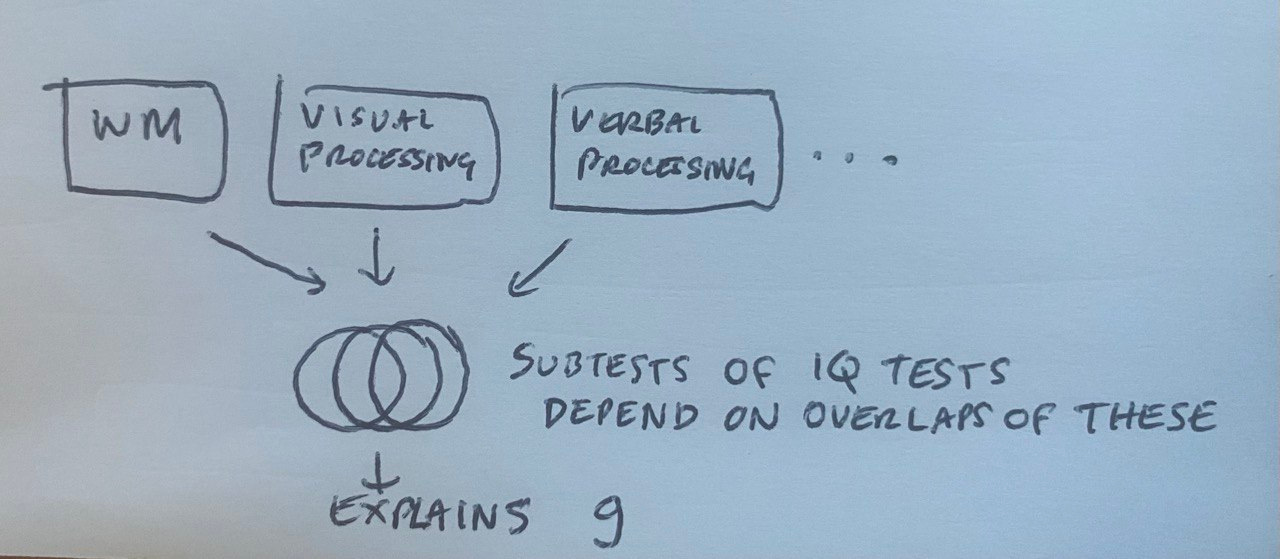

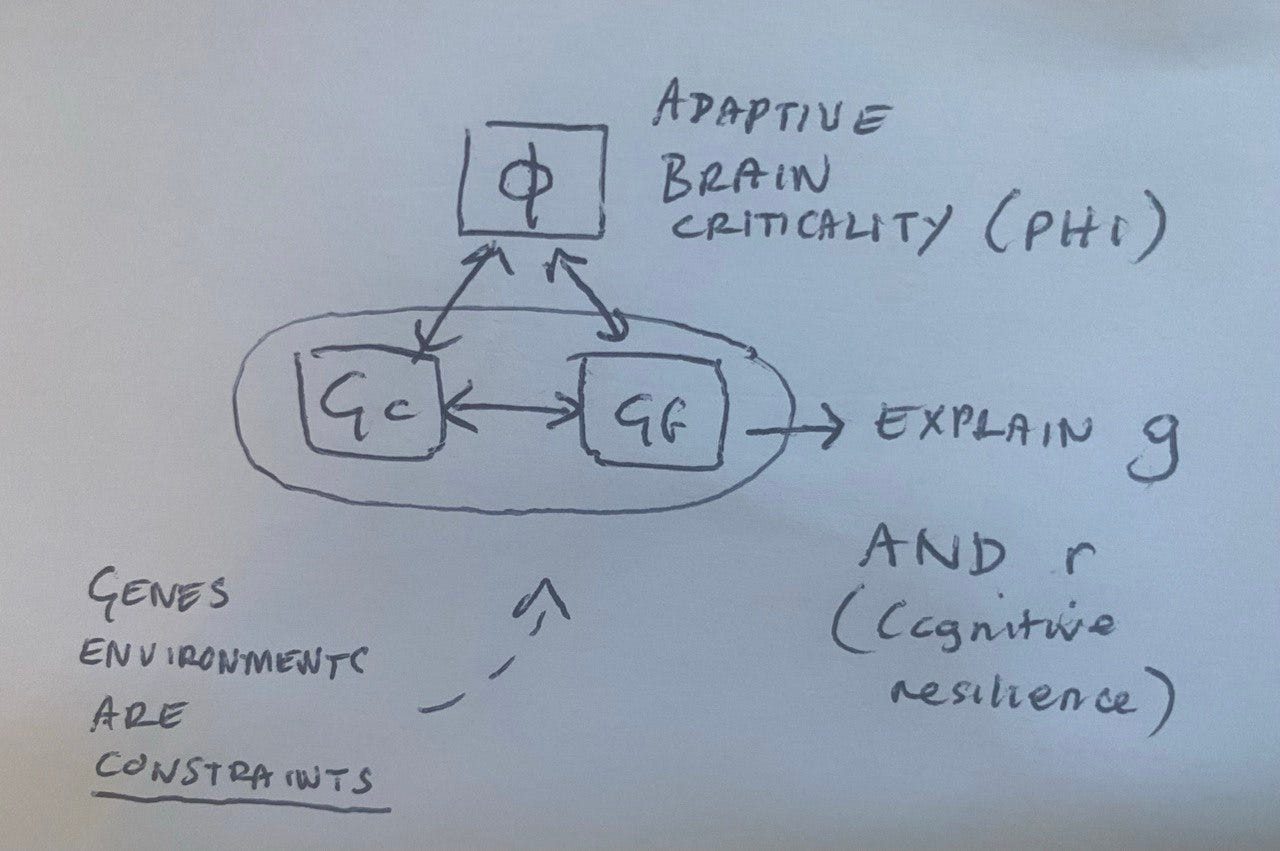
Hello, I wanted to alert you to the fact that your iqmindware .com website appears to have been suspended within the last day by HostMonster. I was reading it just a few hours ago. I don't see any other method for contacting you so hopefully this helps.